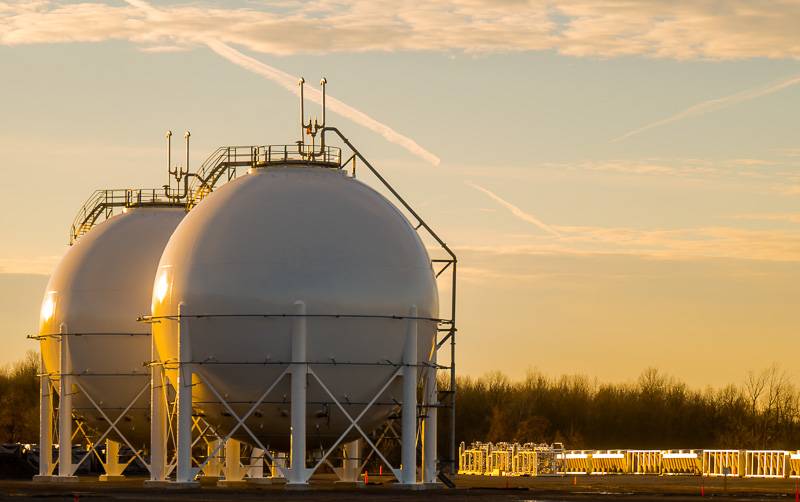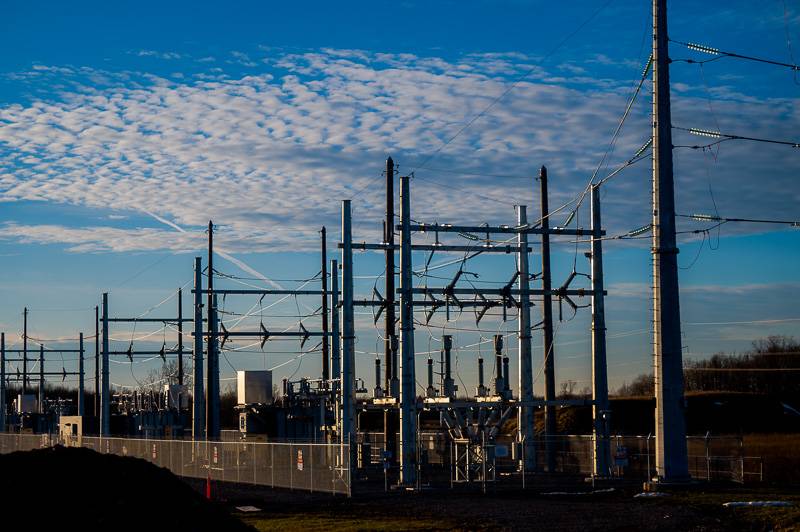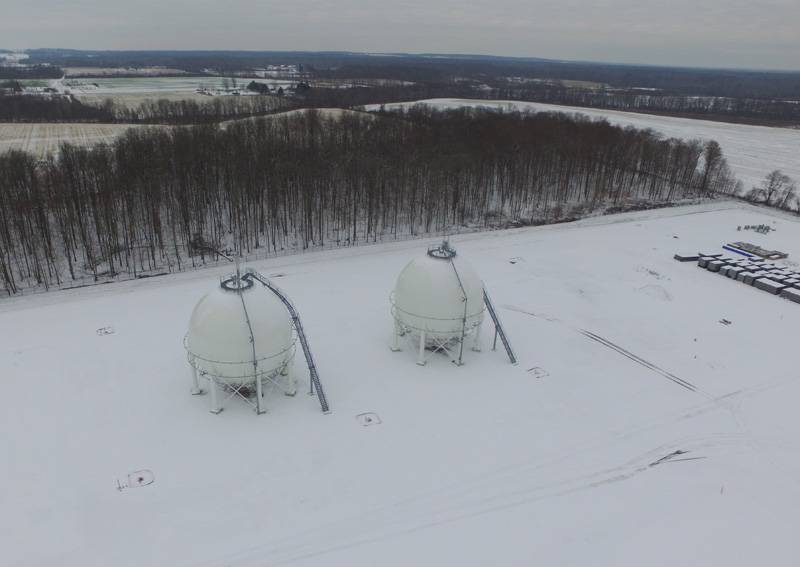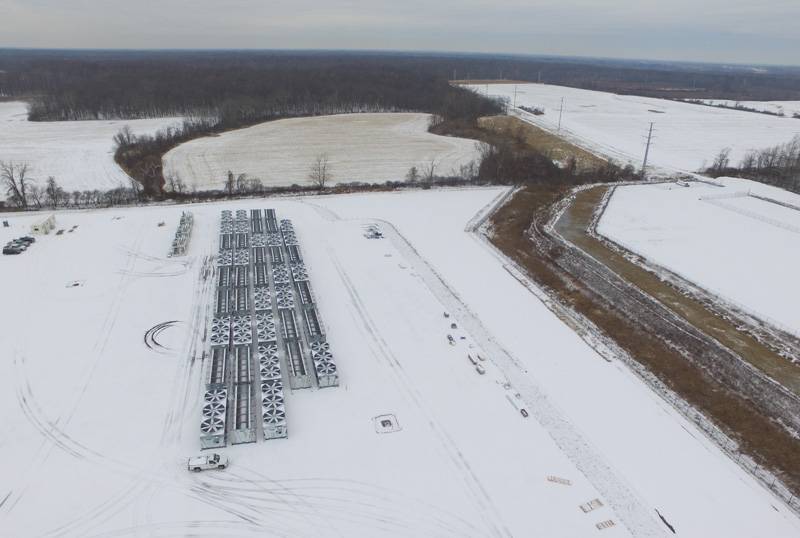
Photo by Howard Owens.
The company's share price hasn't risen above $5 in four months after executives informed investors that it is facing a cash flow problem, and while it has made progress on improving its cash holdings and has increased production at plants in Tennessee and Georgia, there are stock analysts downgrading Plug Power as an investment opportunity.
Even so, Plug Power's leadership indicates the company is plowing ahead with plans to build the nation's leading fully integrated hydrogen power supply company -- a revolution in alternative energy production if Plug Power can pull it off.
One component of that plan is the completion of a hydrogen fuel production facility and electric substation at WNY STAMP, and officials with the company say the project remains on course for production to begin in the first half of 2025.
In collaboration with the New York Power Authority and National Grid, Plug Power expects to achieve its full capacity of 74 tons per day of liquid hydrogen production within that time frame.
"At this point, the majority of the work on-site to date has been laid underground to support the incoming power, drainage, and water management demands of a functional green hydrogen plant," officials said in a statement to The Batavian.
In accordance with Security and Exchange Commission Rules, Plug Power disclosed in November that a shortage of cash threatened its ability to remain a "going concern" within the following 12 months. It suggested it could raise more cash by selling stock and that the company expected to receive a sizable loan from the Department of Energy.
Since then, Plug Power authorized B. Riley Securities to offer additional public shares of the company for sale at market rate with the goal of raising an additional $1 billion in capital. That agreement was announced in January. There has been no news released on how that sale has proceeded.
Also, in January, Plug Power secured a $1.6 billion loan from the Department of Energy to help it complete six liquid hydrogen facilities (including, presumably, the facility at WNY STAMP). Plug Power is expected to receive the funds later this year. CORRECTION: Contrary to the news article cited, the loan has not been finalized, but according to a company representative, the company took another step in the due diligence process toward finalizing the loan. The representative said that Plug Power is at Step 3 of the process in the charge on this page.
Buffalo-based Investigative Post reported on Jan. 30 that the Tonawanda Senecas opposed the loan and were actively lobbying to stop it from going forward.
The Seneca Nation is invested in solar power.
Two days ago, Seaport Res Ptn, a stock analyst firm, downgraded Plug Power from a "buy" position to "neutral," which made headlines in the business press. The Seaport researches projected lower earnings this year for Plug Power.
A New York-based company (Latham) was founded in 1999 and has yet to turn a profit. In its most recent earnings report, in September, it reported $890 million in revenue, a record for the preceding 12 months and a 38 percent year-over-year improvement. Over the same period, the company lost $283.5 million.
In January, Plug Power began fuel production at its new plant in Woodbine. Georgia. The plant is designed to produce 15 tons per day of liquid electrolytic hydrogen, which the company says can power 15,000 forklifts per day.
Two days ago, the company resumed fuel production in Charleston, Tenn. That plant produces 10 tons of liquid hydrogen per day.
The two facilities coming online are expected to reduce Plug Power's cost of production and improve its move toward profitability.
The company's specialty is green hydrogen, which is hydrogen produced without fossil fuels powering the facilities, and then that hydrogen, when used as a fuel source, results in zero carbon emissions. (More info: Forbes Magazine video about green hydrogen featuring Plug Power)
Plug Power's long-term goals are enterprising -- to be the market leader in green hydrogen. It is building a "vertically integrated" business model, which means it can provide customers with hydrogen services in a variety of ways. For an idea of vertical integration, think of Apple. From Apple, you can get an iPhone, iPad, computer, or even earbuds that all work together seamlessly.
Plug Power aims to provide customers with fuel cells, electrolyzers (splitting water into hydrogen and oxygen), to liquid hydrogen fuel. They even provide companies like Walmart and Amazon with hydrogen-powered forklifts. Plug Power wants to provide distribution, delivery, and services and foresees a future for hydrogen that includes uses such as long-haul trucking.
Companies and consumers looking to hydrogen as a green-energy alternative to fossil fuels face many challenges, and Plug Power is attempting to provide solutions to those challenges. The nation currently provides little in the way of hydrogen production and infrastructure, according to industry analysts.
Plug Power's challenges include competition from other fuel sources, including natural gas, solar, and wind, as well as the steep price of building an entirely new vertically integrated infrastructure that can meet global demand.
In an interview with a green energy podcast, Plug Power CEO Andy Marsh said hydrogen power is under attack from industry leaders who believe electricity is the only solution to carbon-driven climate change.
"It's folks who really don't want hydrogen to be part of the solution, and I would contend they really don't understand," Marsh said. "I would like them to explain to me how you clean up long-haul trucking. I'd like them to explain how you do the last mile for 30 percent of the applications. I like them to explain how you do a fertilizer. I like them to explain how you do steel, which represents six or seven percent of the world's carbon footprint -- electricity solves none of that, and it's rather frustrating that if you're really thinking about how, from a system point of view, you clean up greenhouse gas. It's not really possible with their solutions."
He said solving climate change will take all of the green energy alternatives, even including nuclear power.
Plug Power's executives have set ambitious goals -- producing 2,000 tons of hydrogen daily by 2030. At that rate, the company hopes to generate $20 billion in annual revenue at that point with a profit margin of at least 30 percent.
According to Marsh, one ton of green hydrogen is the fuel equivalent of 2,000 gallons of gasoline.
The company selected WNY STAMP for the construction of a liquid hydrogen plant in February 2021. The plant will cost more than $290 million to complete.
Empire State Development is scheduled to pay up to $2 million in Excelsior Tax Credits in exchange for the creation of 68 jobs at the plant, or about $2,941 per job per year over 10 years. Plug Power is not eligible to receive the tax credits until the jobs are filled. The average starting salary is expected to be approximately $70,000 plus benefits.
As part of the project, Plug Power agreed to invest $55 million in a 450-megawatt electrical substation that will make electricity available to other WNY STAMP tenants.
The company received $118.2 million in sales and property tax exemptions from the Genesee County Economic Development Center. Over the 20-year life of the property tax extensions, Plug Power will make payments in lieu of taxes totaling $2.3 million annually, which will be shared by Genesee County, the Town of Alabama, and the Oakfield-Alabama School District. Each jurisdiction will also receive an increasing amount of property tax payments each year over the life of the agreement.
The STAMP plant, based on available descriptions of the other plants operated by Plug Power, would be the company's highest capacity plant.
If Plug Power were to go out of business, there's no information available on what might become of the hydrogen fuel facility. When Pepsi/Muller closed its plant in Batavia, followed by the failure of Alpina, both plants readily found new operators in HP Hood and Upstate Milk Cooperative, respectively; while there are other hydrogen companies and other energy companies, it's unknown if any would be interested in the Plug Power facility if it became available.
For previous Plug Power coverage, click here.



